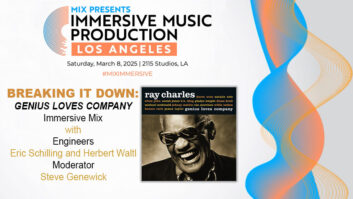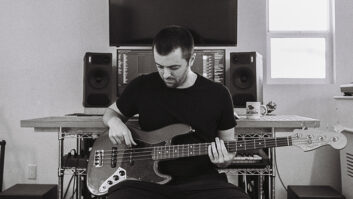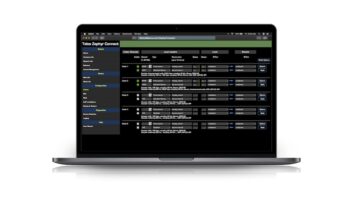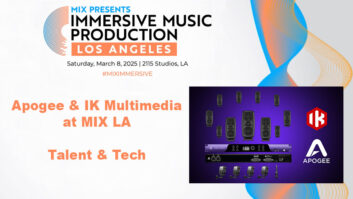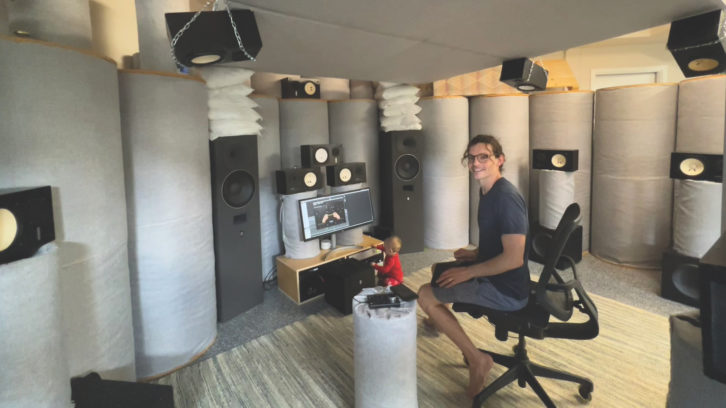
Music and recording are imprinted in Jesse Ray Ernster’s DNA. Born in Winnipeg and raised in the Twin Cities, he inherited his deep love of music and production from his father, a recording engineer, and his mother, a singer-songwriter.
Ernster was all-in at an early age, bouncing tracks on his cassette deck and building toy stages outfitted with flashlights and tiny P.A.s built from Logitech computer speakers. He spent his high school years in his dad’s studio, recording his rock bands and honing his production chops.
He went on to teach engineering and mixing courses at the Minneapolis Media Institute, located in the old Flyte Tyme Studios, recording bands in his spare time in a rented lakefront cabin that he transformed into a multiroom studio.
Ernster made the leap to Los Angeles in 2017. Those first few years were a hustle, teaching music lessons, performing in wedding bands, offering editing and Auto-Tuning services, and composing for film and TV (including work on Ripley’s Believe It or Not!).
His trajectory took a turn when a chance encounter with Kanye West led to a gig engineering West’s Jesus Is King and Donda, which earned Ernster his first Grammy Awards. Since then, he’s become a first-call mixer of A-list artists, winning a Grammy for his work on Burna Boy’s Twice as Tall and gaining accolades for his contributions to Doja Cat’s smash hit “Woman” and other tracks from her Grammy-winning album Planet Her. Between sessions, he launched a plug-in company and built a one-of-a-kind Dolby Atmos rig.
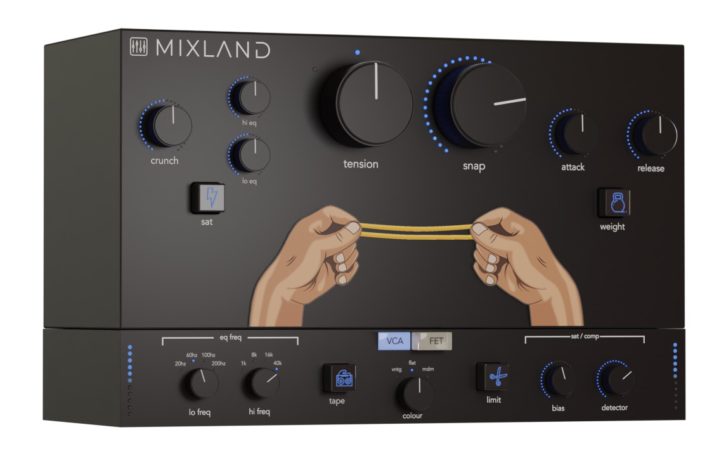
I’m just going to jump right into the legendary donut story. You had just landed in L.A., and you were searching for a gig…
I applied at every studio in town, sent resumes out, called multiple times. Nothing was working, nobody was hiring. I thought, “I have to hone in on what I do, and I feel like I’m a bold, hyperactive guy. I’ve got to do something quirky.”
I printed out these full-color resumes in comic sans font and taped them to the tops of boxes of donuts. I filled up my Jeep, floor to ceiling, with boxes, and brought them to every single studio in the valley. Finally, at the end of the day, it worked, at NRG. Jillian, the manager there, said, “That’s incredibly cool. When can you start?”
Fast-forward to a session at Nightbird. You were working with Tgya.
I got a random call to go in and sub engineer a session for Tyga. Then Kanye came in. He was carrying his MacBook, and he was like, “I want to play you guys some of the new album.”
He played us a bit of the unreleased material, and I thought, “Man, these are great records. I love it.” It was one of those “L.A. moments,” the once-in-a-lifetime encounters that happen in this city that I had always heard about. I kept thinking, “I have to say something. I have to work with this guy.” He hung out there for a few hours while I worked up the courage to do the unthinkable: leave my chair, overstep my role, and approach the icon known as Kanye West. My mind was racing with the insane dilemma: “Do I say something? I shouldn’t say anything. I could get blacklisted.”
Finally, I thought, “What the hell? I have to go for it.” But he had already grabbed his laptop and was leaving the studio. I impulsively jumped up and followed him out of the room. I kind of cornered him at the end of the hall and said, “Hey, man, I loved what I heard in there. I really respect what you do. I’d love to come work with you.”
He froze, he turned his head and looked at me … I thought, “Man, I’m about to be decked, or he’s going to call me out, and they’re going to get me out of here.” Then he said, “Okay, cool. Give me your number.”
They flew me to Chicago the next day. We went to Uganda, we recorded on the Nile River. We recorded in a tent; you could see hippos and alligators down below our recording area. We went on a safari with Kanye and his family. It was an unbelievable experience.
Would you say that set your career on a new arc?
It was absolutely the first domino to fall, but it wasn’t instantaneous. I had to work really hard to leverage the Kanye opportunity into gaining recognition and other work. I was under NDA, and the album hadn’t yet come out, so I was quite limited in the promotional reach I had to acquire other clients and projects.
Ultimately, I met with the Bad Habit management label and they placed me with UMI and Burna Boy as clients right away. I mixed Burna Boy’s Grammy-nominated African Giant LP, as well as a bunch of UMI songs that have gone on to rack up hundreds of millions of streams.
Let’s talk about your studio. It’s in your home. Do you work mostly in the box?
I am all in the box now. And to my ear, that is not a compromise in quality whatsoever. There are no limitations to the sonic capabilities of plug-in technology these days. In fact, there’s much more flexibility than ever before, and it’s all recallable.
I understand that you designed the acoustic treatment?
Yes. These are large 27-inch tube traps inspired by the ASC isothermal tube traps. The design features an absorptive front side, diffusive back side, and an isothermal layer of loose batting insulation on the inside. When the tubes are assembled into an attack wall configuration, it separates the listener from the subspace of the room and creates an entirely new level of monitoring accuracy. They neutralize and control problematic sound waves all the way down into the sub frequencies, while keeping the room feeling natural and lively.
Tell me about your Atmos system. You’re a big fan of Yamaha NS10s; you have something like 10 pairs in there.
I absolutely love NS10s. It’s the speaker I learned on, so I’m quite familiar with the sonic stories they tell. The microdynamics are just superb, and their ability to reveal imbalances and resonances across the spectrum is just astonishing to me. For Atmos, the NS10s’ biggest strength is in their speaker-tospeaker imaging; they really present a convincing image when panning objects around. Plus, I’ve been experimenting with modifying the crossovers to help tame a bit of the resonances and distortion around 1.6 kHz. The mod sounds amazing.
Classic Tracks: Duran Duran’s “Hungry Like The Wolf”
The entire system is being run with the Apogee Symphony MkII + Atmos remote, allowing me to customize speaker layouts, switch between different monitoring and input sources, and dial in the overall calculated delay from speaker to speaker so everything stays locked in and sounding great. It’s an absolute dream rig.
I’ve heard you talk about your “no-desk movement.” How does this work?
Essentially, I have ditched the desk! Those massive, clunky desk surfaces create incredibly problematic reflections, cancellations and comb-filtering effects that ultimately provide the user with an inaccurate representation of the sound source. I’ve spent some time in a few hi-fi listening rooms where there’s nothing between the listener and the speakers, and it’s an unbelievably pure experience. I wanted to recreate that. I wanted to minimize the guesswork and translation issues I was encountering, so I ditched the desk and adopted the “lapdesk,” which is basically a keyboard and mouse that sit in my lap. The translation is a night-and-day difference, meaning that the choices I make in the studio sound the same when I check in the car or on AirPods.
Let’s switch to the right brain. How do you balance serving the artist’s creative vision and your ideas?
I definitely have an aesthetic that I go for, because I am a fan of big, clean, classic recordings: Dire Straits, James Taylor, The Wallflowers, Pink Floyd. At the same time, I’m also quite obsessed with harmonic texture, growling saturation, and crunchy vibe when applied tastefully. It’s the marriage of these two worlds—clean and distorted—that creates a captivating aesthetic experience for me as a listener and creator. With that in mind, it’s not always my role to make big decisions in the mixing stage; a lot of the time, those sonic choices have already been decided. It’s about what the artist wants, and I’m ultimately happy to serve them in any creative capacity.
Tell me about Doja Cat. Did the team approach you?
I got a DM from Yeti Beats, her executive producer. He said, “I’ve got this record for Doja Cat that we need mixed. It’s kind of an Afrobeat thing. We heard what you did on African Giant, and we’re all about it. Would you like to try it out on spec?” I said, “Yes! Let’s go!” I got the files from him, we spoke about the direction and the vision, and I went for it.
And yes, I absolutely took some liberties on that one! [laughs] I completely swapped out the kick drum and really brightened up the vocals quite a bit. I also added some production to the intro to provide more of a dynamic crescendo transition into the first hook—which ended up informing some of the CGI treatment in the music video.
Let’s talk about the Rubber Band Compressor. How did you get into the plug-in business?
I’ve teamed up with Eddie Lucciola, the creator of Kiive Audio. He codes the Mixland plug-ins, and I handle the conceptualizing, content marketing, and the business side of it. We’ve built six plug-ins together now, and have a bunch more coming out, including the Rubber Band Compressor V2, which just launched at NAMM. We completely rebuilt it from the ground up for unbelievable fidelity and resolution. It’s an exceptionally bouncy and snappy-sounding compressor/EQ/saturator/channel strip.
You’re really open when it comes to sharing information.
Totally. I am a proponent of building up the next generation of music-makers into a large-scale support community with a strong mentality of sharing knowledge. My colleagues, my peers, they’re my friends. I don’t believe in competitors; only friends and collaborators. There is enough work to go around.
